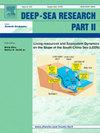Impacts of barite and bentonite sedimentation on the behaviour, mucus production and cnidocytes of the deep-sea coral Flabellum (Ulocyathus) alabastrum
IF 3
3区 地球科学
Q2 OCEANOGRAPHY
Deep-sea Research Part Ii-topical Studies in Oceanography
Pub Date : 2025-08-23
DOI:10.1016/j.dsr2.2025.105536
引用次数: 0
Abstract
As oil and gas exploration expands in deep-sea environments, understanding the impacts of wastes produced by this industry is urgent. One of the main wastes of offshore drilling is the discharge of drill muds, commonly including barite and bentonite clay. Here, we investigated the effects of these two byproducts on the expansion behaviour, mucus secretion and cnidocyte density of the solitary cup coral Flabellum (Ulocyathus) alabastrum. A total of 96 live corals were exposed over 10 days to one of three treatments (barite, bentonite, or barite and bentonite combined) or assigned as an untreated control. Daily waste additions aimed to reach a total sedimentation depth of 6.3 mm (common ‘probable no-effects threshold’). Photography was used to monitor behavioural changes and mucus production, and histology was used to assess changes in tentacle cnidocytes. Overall, responses of F. alabastrum in the form of excessive polyp expansion (swelling) and mucus production were more severe under the barite and bentonite combined treatment, followed by barite alone, bentonite alone and lowest/absent in the control. Moreover, elevated nematocyte densities were measured under exposure to the mix of barite and bentonite. However, F. alabastrum returned to baseline metrics during a 10-day recovery period. The results suggest that sedimentation of common drill mud ingredients to <6.3 mm depth can cause observable and non-lethal responses in F. alabastrum, but remain conservative relative to what may be experienced in situ. As the most adverse effects were observed under the barite and bentonite combination treatment (tested together for the first time here), potential synergistic effects of the two should be considered in future research. Understanding long-term consequences, as well as impacts of more abrasive drilling waste (drill cuttings) on F. alabastrum requires further study.
重晶石和膨润土沉积对深海珊瑚Flabellum (Ulocyathus) alabastrum行为、粘液生成和刺丝细胞的影响
随着石油和天然气勘探在深海环境中的扩展,了解该行业产生的废物的影响迫在眉睫。海上钻井的主要废物之一是钻井泥浆的排放,通常包括重晶石和膨润土粘土。本文研究了这两种副产物对单杯珊瑚Flabellum (Ulocyathus) alabastrum的膨胀行为、粘液分泌和刺胞细胞密度的影响。共有96个活珊瑚在10天内暴露于三种处理(重晶石、膨润土或重晶石和膨润土混合)中的一种,或被指定为未经处理的对照组。每日添加废物的目标是达到总沉降深度6.3毫米(常见的“可能无影响阈值”)。摄影用于监测行为变化和粘液产生,组织学用于评估触须毛囊细胞的变化。总体而言,重晶石和膨润土联合处理下,alabastrum的反应以息肉过度膨胀(肿胀)和粘液产生的形式更为严重,其次是单独的重晶石,单独的膨润土,而对照组最低或没有。此外,在暴露于重晶石和膨润土混合物下,测量了线虫细胞密度的升高。然而,在10天的恢复期内,鹅角菇恢复到基线指标。结果表明,普通钻井泥浆成分沉积至6.3 mm深度可引起F. alabastrum的可观察和非致命反应,但相对于原位可能经历的反应仍然保守。由于重晶石和膨润土组合处理(本文首次同时进行试验)的不良反应最多,因此在今后的研究中应考虑两者的潜在协同效应。了解长期后果,以及更多的研磨性钻井废物(钻屑)对alabastrum的影响,需要进一步研究。
本文章由计算机程序翻译,如有差异,请以英文原文为准。
求助全文
约1分钟内获得全文
求助全文
来源期刊
CiteScore
6.40
自引率
16.70%
发文量
115
审稿时长
3 months
期刊介绍:
Deep-Sea Research Part II: Topical Studies in Oceanography publishes topical issues from the many international and interdisciplinary projects which are undertaken in oceanography. Besides these special issues from projects, the journal publishes collections of papers presented at conferences. The special issues regularly have electronic annexes of non-text material (numerical data, images, images, video, etc.) which are published with the special issues in ScienceDirect. Deep-Sea Research Part II was split off as a separate journal devoted to topical issues in 1993. Its companion journal Deep-Sea Research Part I: Oceanographic Research Papers, publishes the regular research papers in this area.

 求助内容:
求助内容: 应助结果提醒方式:
应助结果提醒方式:


